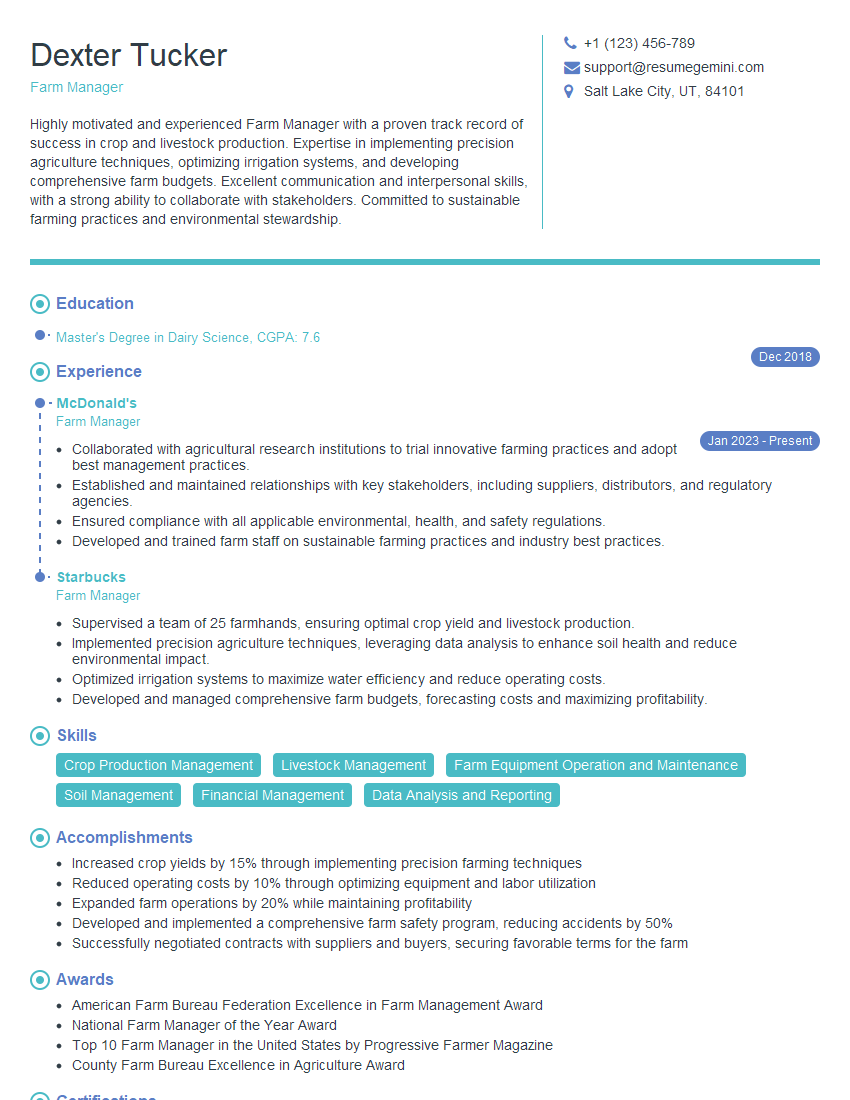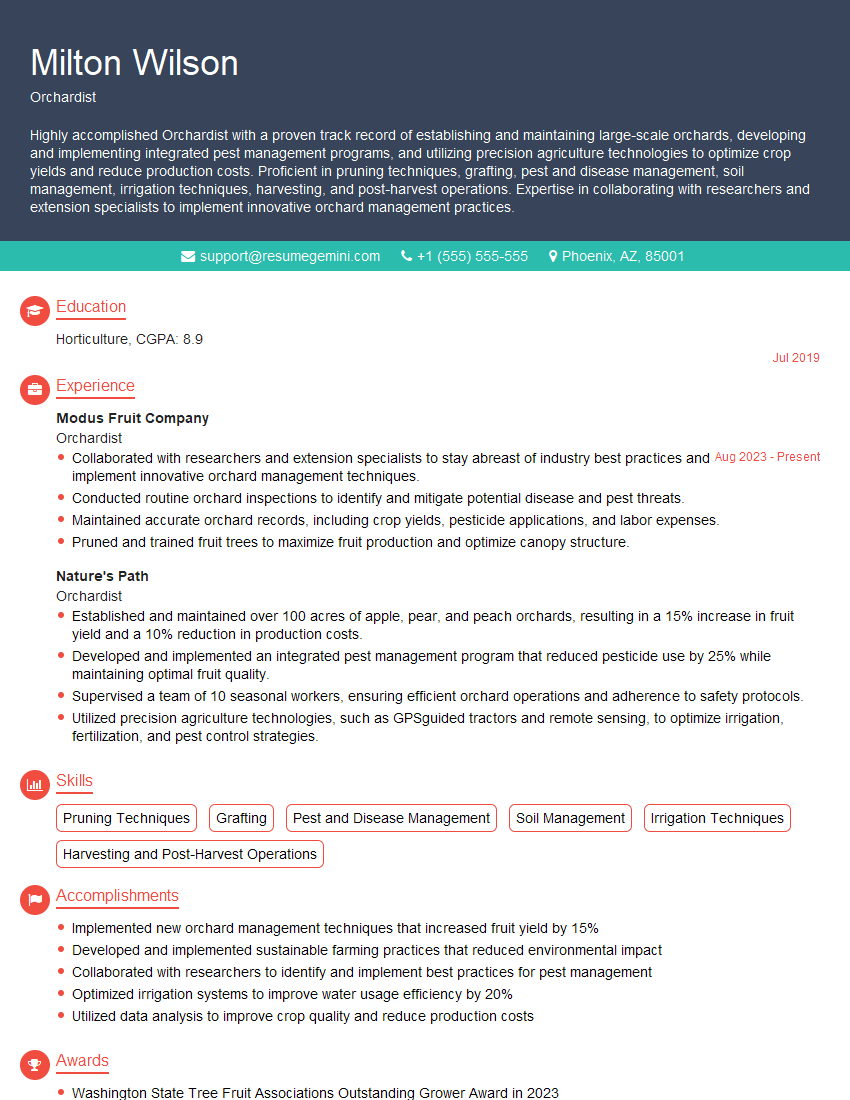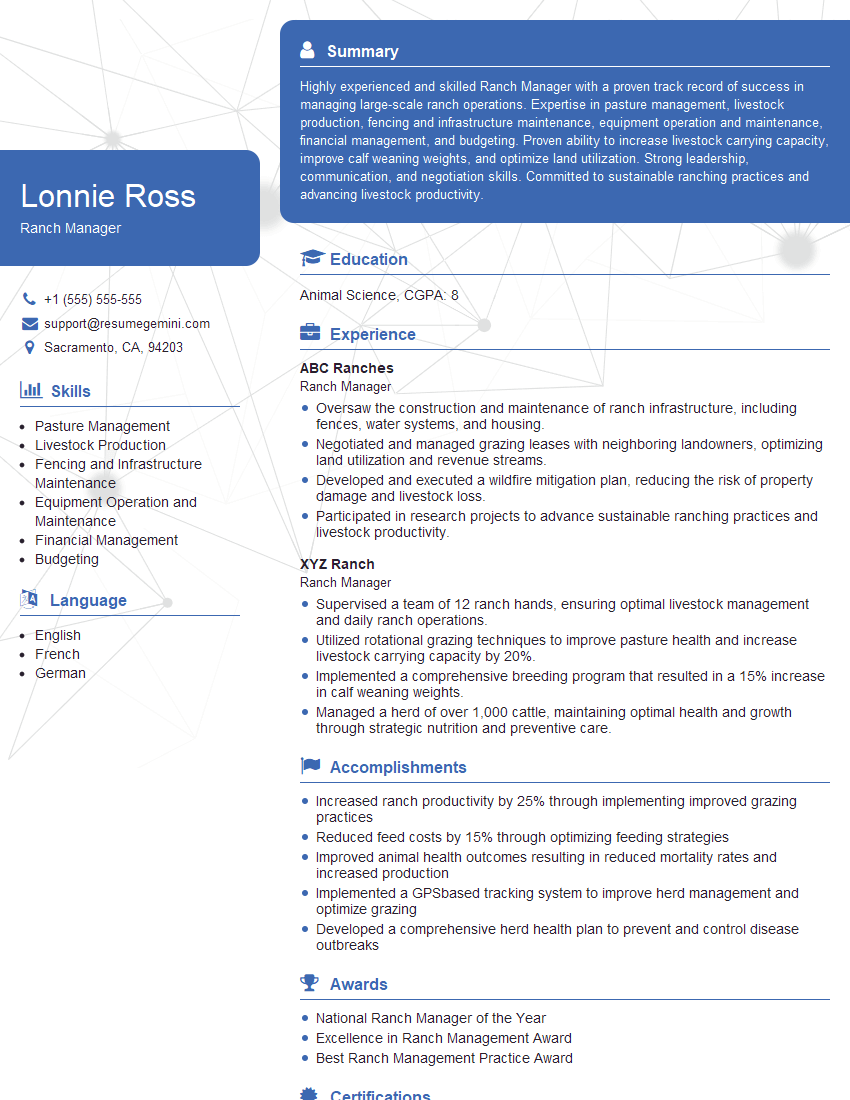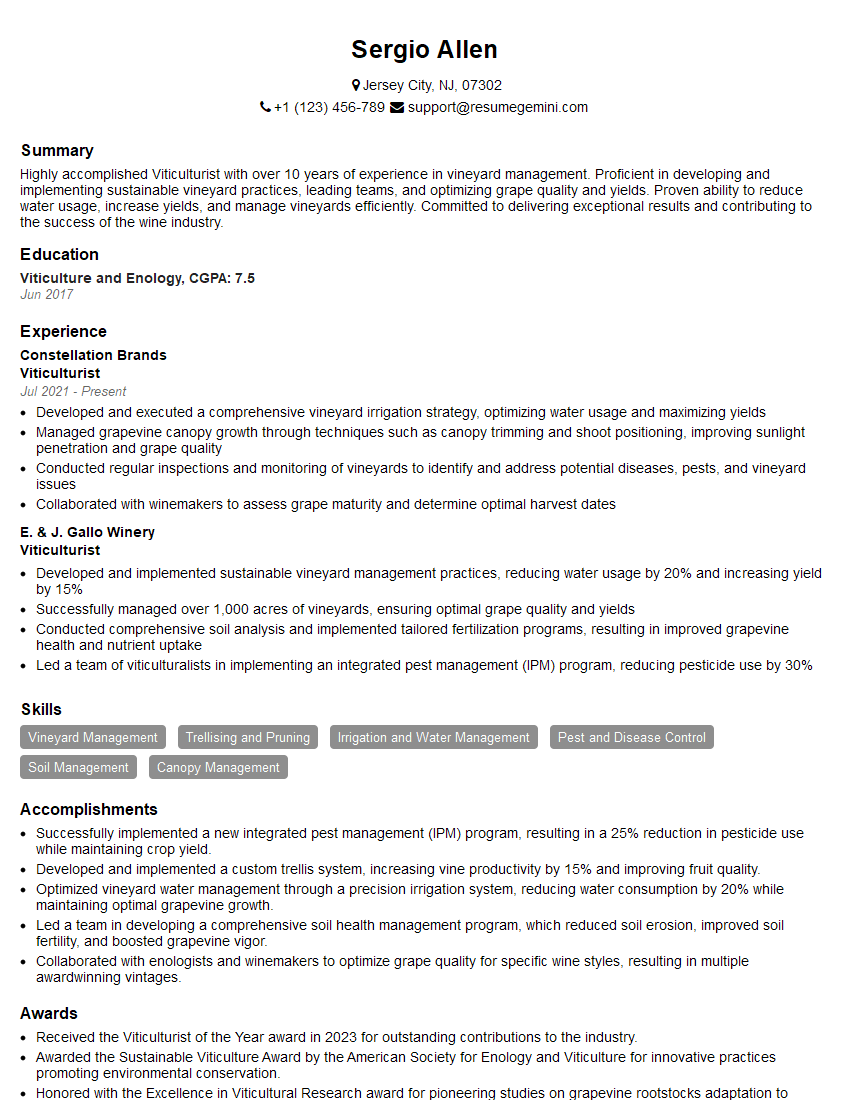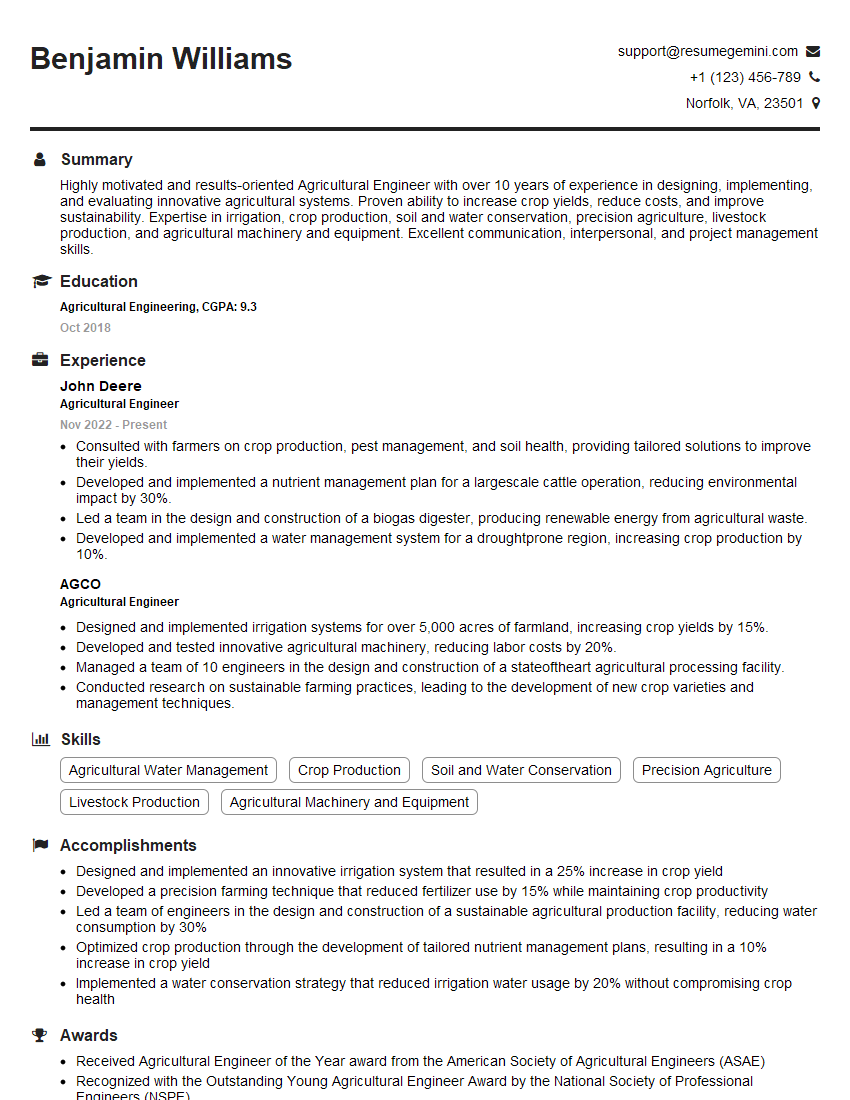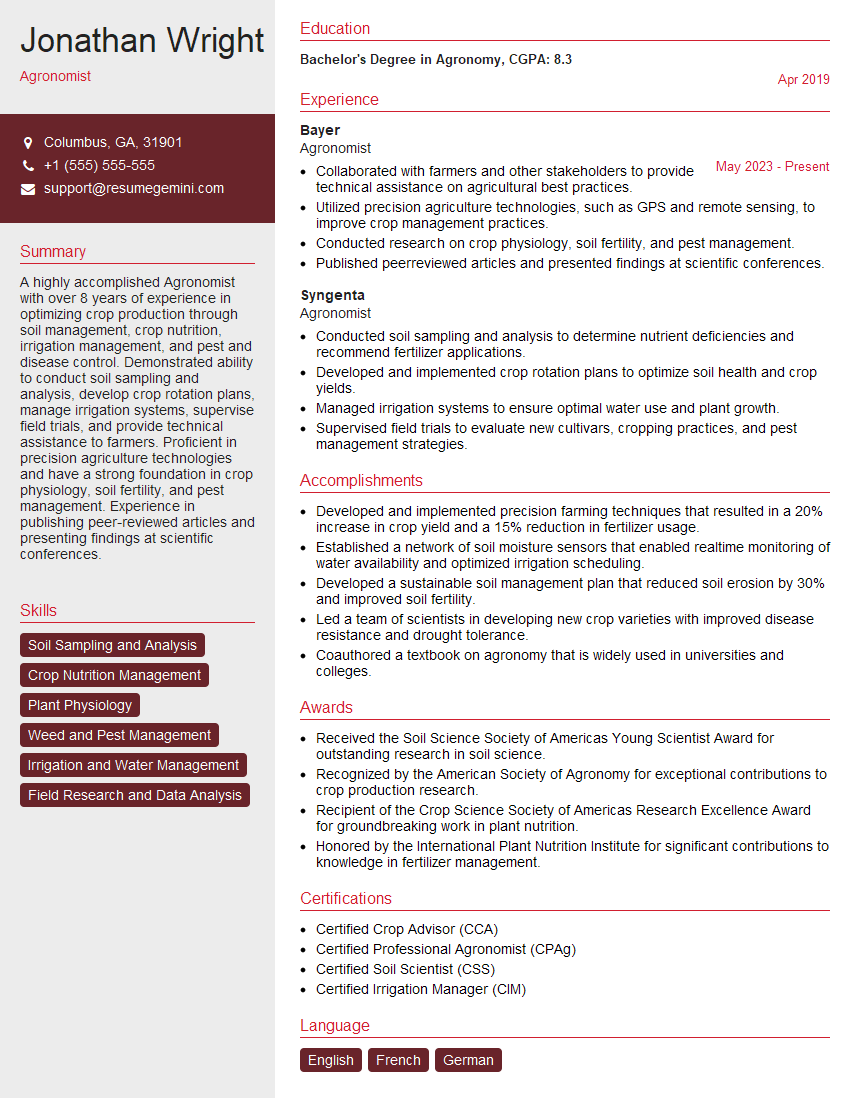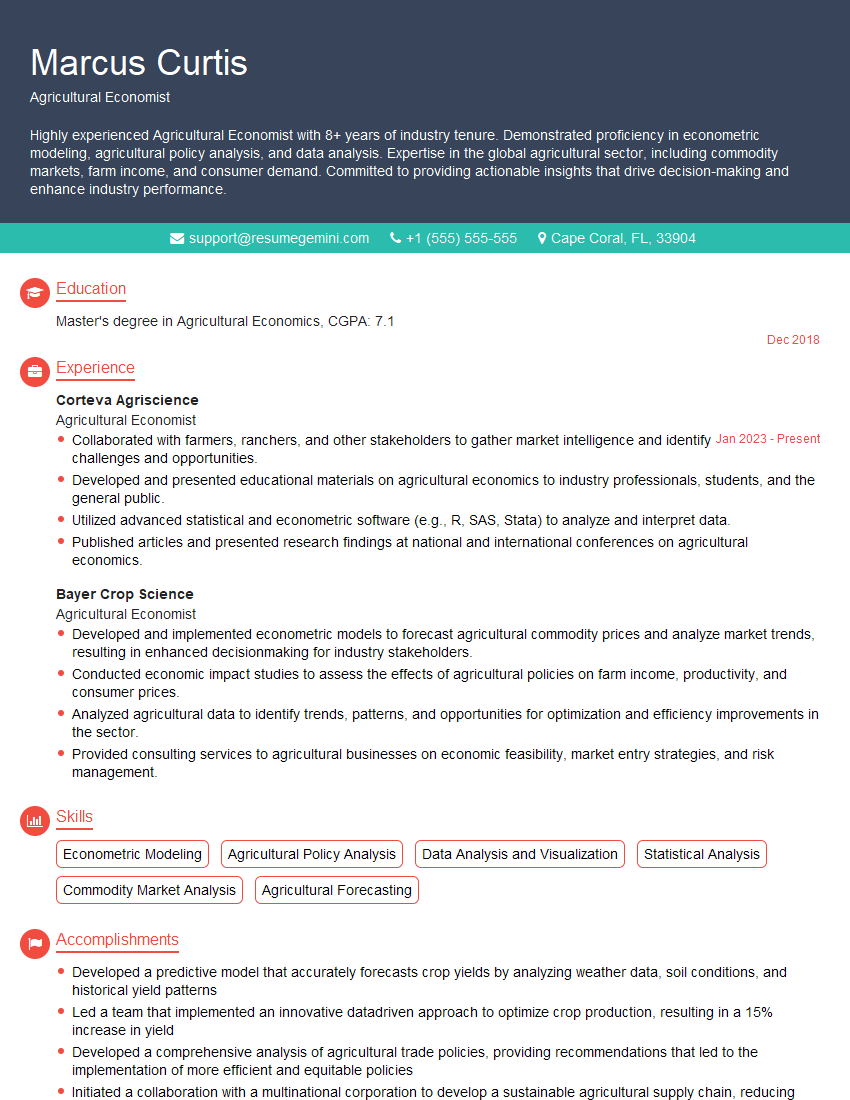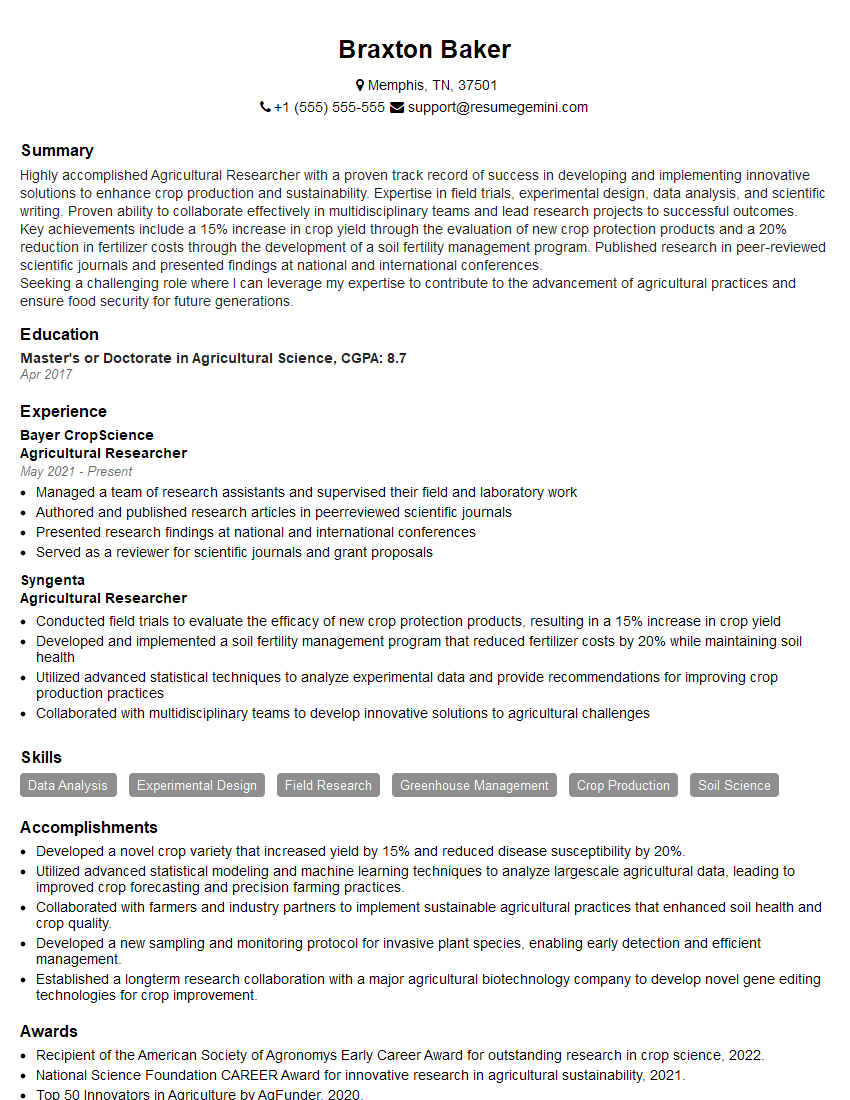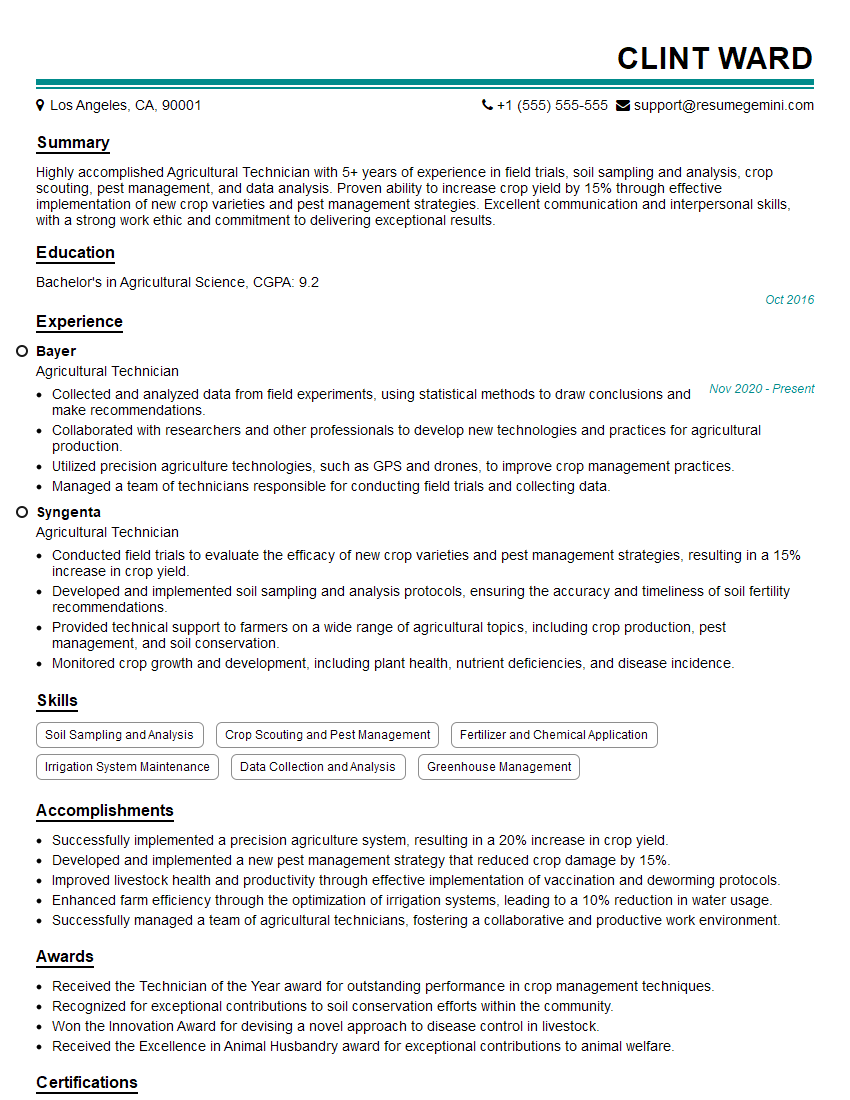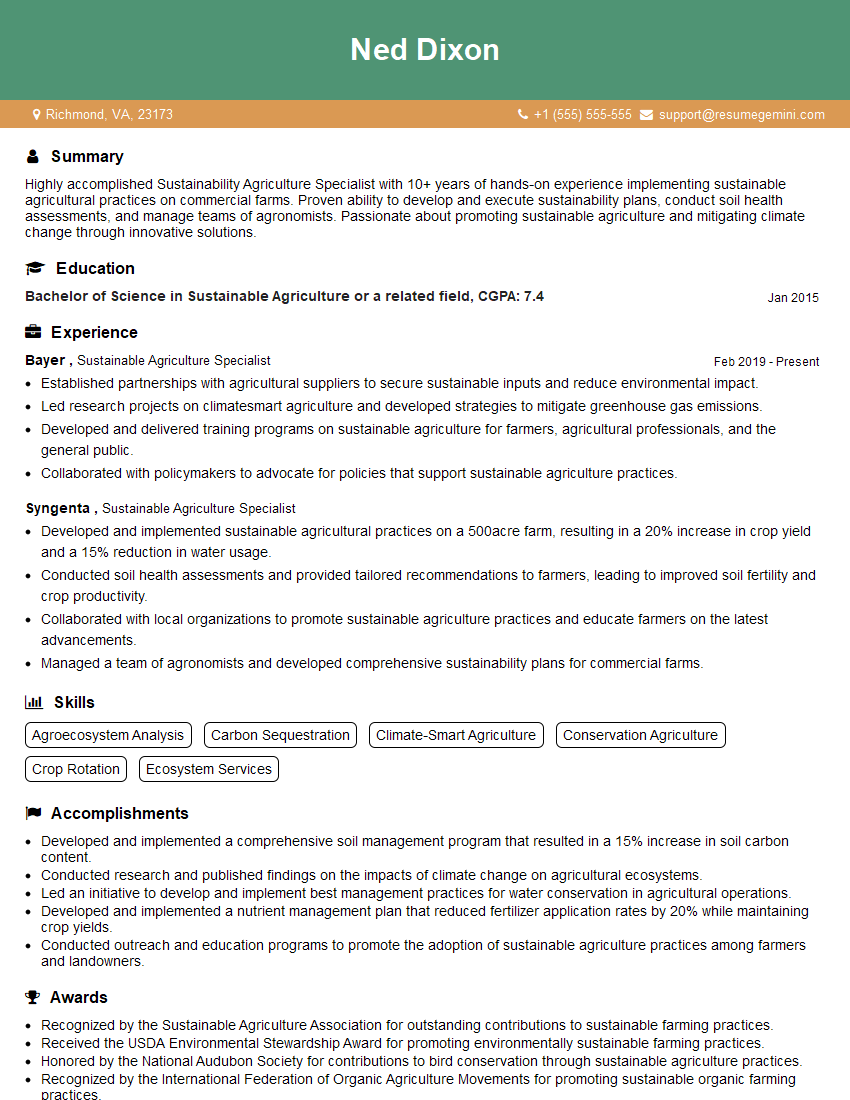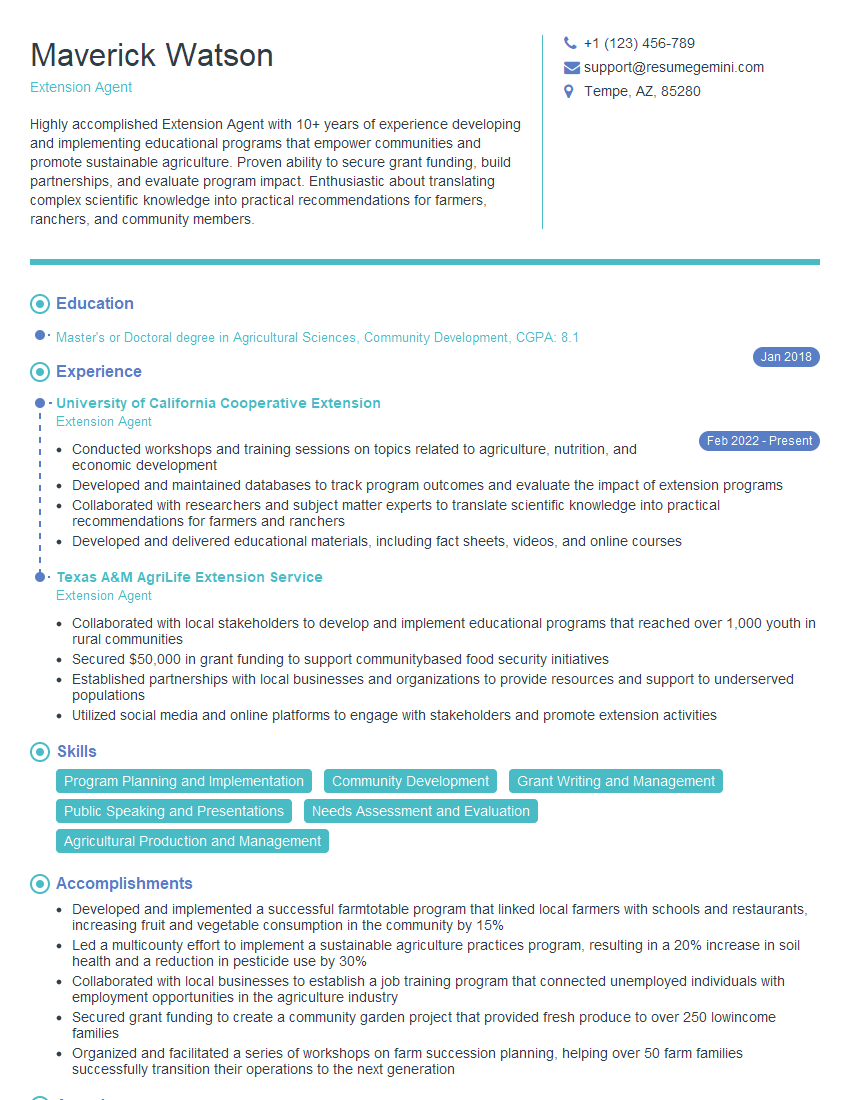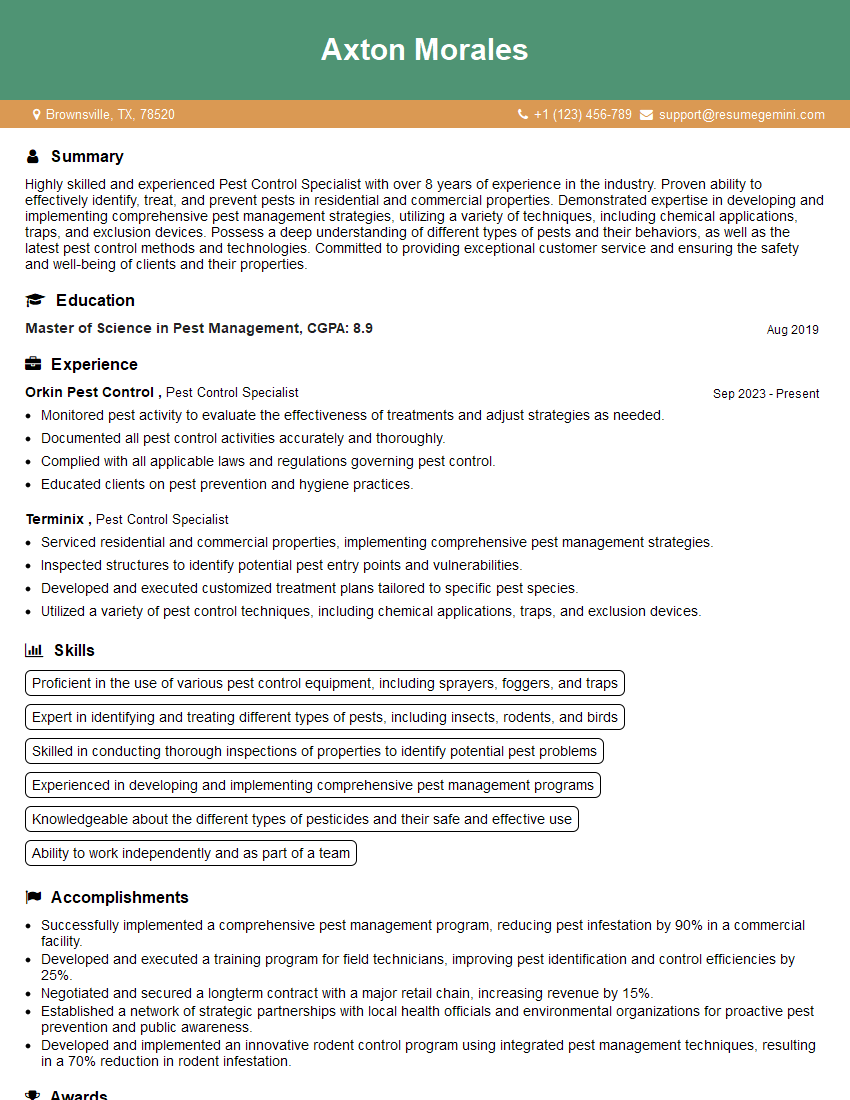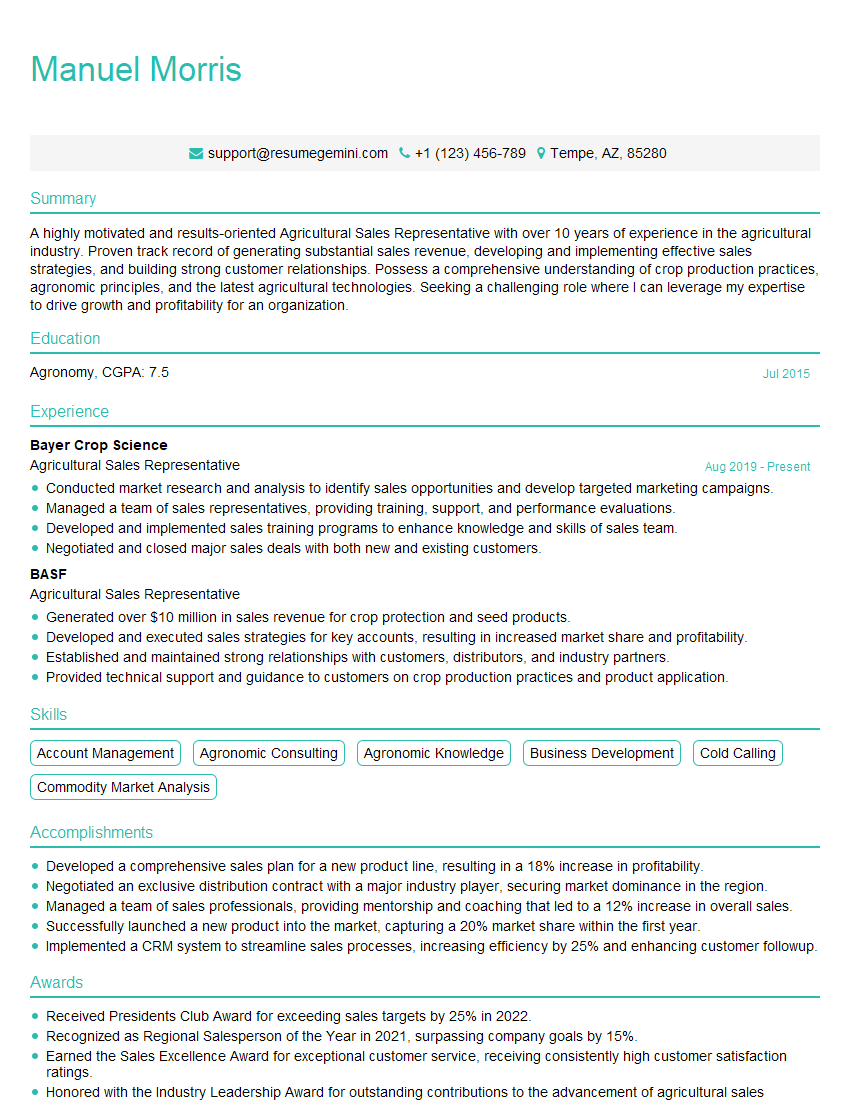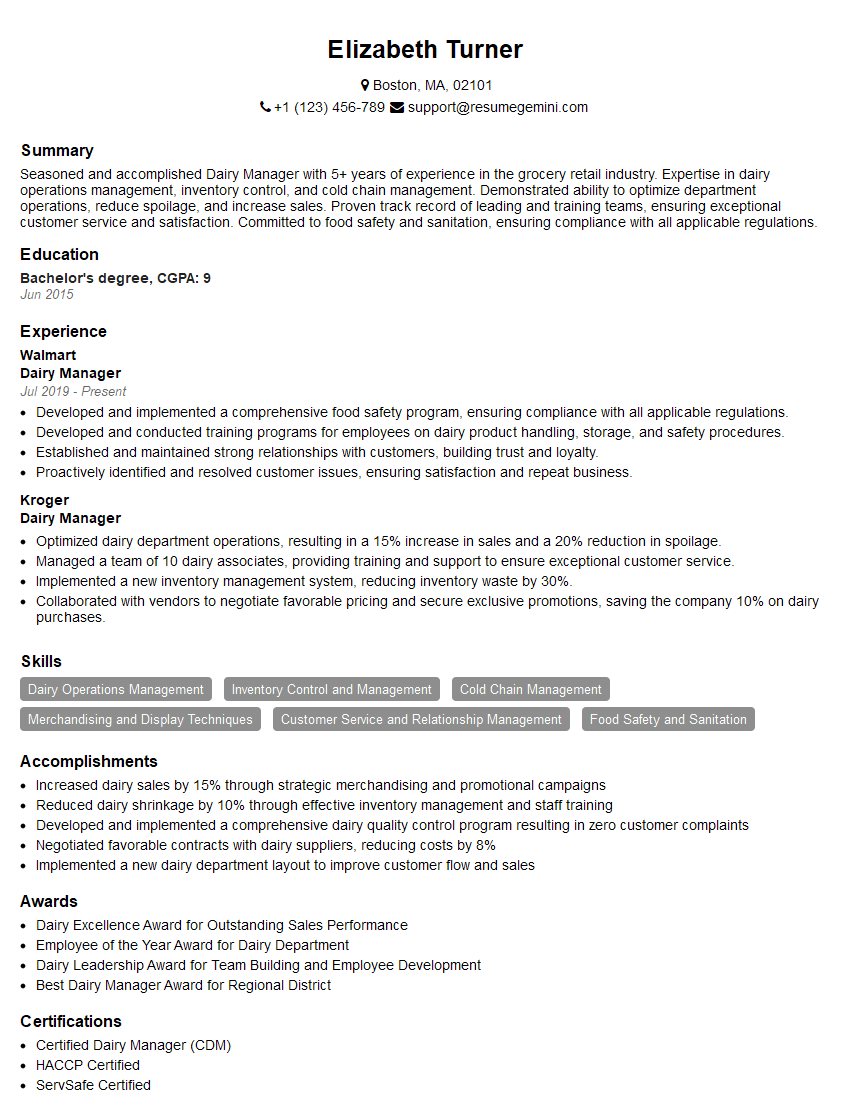Are you ready to stand out in your next interview? Understanding and preparing for Passion for Agriculture interview questions is a game-changer. In this blog, we’ve compiled key questions and expert advice to help you showcase your skills with confidence and precision. Let’s get started on your journey to acing the interview.
Questions Asked in Passion for Agriculture Interview
Q 1. Describe your experience with different irrigation techniques.
Irrigation is the artificial application of water to land to assist in the production of crops. My experience encompasses a range of techniques, each with its own strengths and weaknesses.
- Flood Irrigation: This is the simplest method, involving flooding a field with water. It’s inexpensive but inefficient, leading to significant water loss through evaporation and runoff. I’ve seen this used successfully in flat, low-lying areas with readily available water sources, but it’s not ideal for sloping land or water-scarce regions.
- Furrow Irrigation: Water flows along furrows or channels between crop rows. It’s more efficient than flooding but still prone to runoff and evaporation. I’ve found this method suitable for crops like potatoes or corn where the rows can be easily channeled.
- Drip Irrigation: This technique delivers water directly to the plant roots through a network of pipes and emitters. It’s highly efficient, minimizing water waste and maximizing water use. I’ve successfully implemented drip irrigation in vineyards and high-value vegetable production, significantly increasing yield and reducing water consumption.
- Sprinkler Irrigation: Water is sprayed over the field using sprinklers. This method is versatile and can be used on various terrains but can be less efficient than drip irrigation due to evaporation and wind drift. I’ve observed its effectiveness in orchards and larger field crops.
- Subsurface Drip Irrigation (SDI): Water is delivered below the soil surface through buried tubing, minimizing evaporation and improving water use efficiency. This is a cutting-edge method I’ve explored and it has shown great promise in arid and semi-arid regions for water conservation.
Choosing the right irrigation technique depends heavily on factors like topography, soil type, crop type, water availability, and cost considerations. My approach always prioritizes water conservation and efficient resource management.
Q 2. Explain the principles of crop rotation and its benefits.
Crop rotation is the practice of planting different crops in a planned sequence on the same piece of land over several growing seasons. It’s a cornerstone of sustainable agriculture. The principles revolve around breaking pest and disease cycles, improving soil health, and optimizing nutrient utilization.
- Pest and Disease Management: Rotating crops disrupts the life cycle of pests and pathogens specific to certain plants, reducing their populations and minimizing the need for pesticides. For example, planting a legume after a susceptible crop can naturally suppress soilborne diseases.
- Soil Health Improvement: Different crops have different nutrient requirements and root structures. Rotating crops with varying root depths and nutrient needs helps maintain a balanced soil ecosystem. Legumes, like soybeans or clover, fix nitrogen in the soil, benefiting subsequent crops.
- Weed Control: Certain crops can suppress weeds more effectively than others. Crop rotation can reduce weed pressure, reducing the need for herbicides.
- Nutrient Management: Different crops extract different nutrients from the soil. Rotating crops helps prevent nutrient depletion and maintains soil fertility. For instance, heavy feeders like corn benefit from being followed by a nitrogen-fixing legume.
A simple example of crop rotation might be: Year 1: Corn; Year 2: Soybean; Year 3: Wheat. The benefits are clear: healthier soil, reduced pest pressure, and increased overall yield over the long term. I always recommend tailoring rotation plans to specific regional conditions and crop types.
Q 3. What are the key challenges facing sustainable agriculture today?
Sustainable agriculture faces numerous challenges today, many interwoven and demanding holistic solutions.
- Climate Change: Increasing temperatures, erratic rainfall patterns, and extreme weather events significantly impact crop yields and threaten food security. Adapting farming practices to climate change is crucial.
- Water Scarcity: Water resources are becoming increasingly stressed, particularly in arid and semi-arid regions. Efficient irrigation techniques and water conservation strategies are paramount.
- Soil Degradation: Intensive farming practices can lead to soil erosion, nutrient depletion, and loss of soil organic matter. Improving soil health through sustainable practices is essential.
- Pest and Disease Resistance: Pests and diseases are constantly evolving, developing resistance to conventional pesticides. Integrated pest management strategies are necessary.
- Economic Viability: Farmers often face economic pressures that make adopting sustainable practices challenging. Fair pricing mechanisms and government support are crucial for fostering sustainable agriculture.
- Consumer Demand: Balancing the demand for affordable food with the need for sustainable production practices is a continuous challenge. Educating consumers about sustainable food systems is vital.
Addressing these challenges requires a multi-faceted approach, involving technological innovation, policy changes, and a shift in consumer attitudes toward sustainable food systems.
Q 4. How do you manage pest and disease outbreaks in crops?
Pest and disease management is a crucial aspect of successful agriculture. My approach focuses on Integrated Pest Management (IPM), a holistic strategy that combines various techniques to minimize pest and disease impact while minimizing environmental harm.
- Monitoring: Regular monitoring of crops for signs of pests and diseases is crucial for early detection. This often involves visual inspections and potentially using traps or diagnostic tools.
- Cultural Controls: These involve manipulating the growing environment to make it less favorable for pests and diseases. Examples include crop rotation, adjusting planting dates, and using resistant varieties.
- Biological Controls: This involves using natural enemies of pests, such as beneficial insects or microbial agents, to suppress pest populations. This approach often complements cultural control methods.
- Chemical Controls: When necessary, targeted pesticide applications can be used, but only as a last resort and with careful consideration of environmental impact. I prioritize selecting the least-toxic options and adhering strictly to label instructions.
For example, if I detect aphids on a crop, I might first try increasing beneficial insect populations by planting flowering plants that attract ladybugs. If that’s not sufficient, I might consider a targeted insecticide application with a low environmental impact.
Q 5. What are your experiences with precision agriculture technologies?
Precision agriculture technologies are transforming farming practices, enabling data-driven decision-making to optimize resource use and improve efficiency.
- GPS and GIS: I utilize GPS technology for precise field mapping and location-specific data collection. GIS software helps visualize and analyze this data for better management decisions.
- Remote Sensing: Satellite imagery and drone technology provide valuable information on crop health, water stress, and nutrient deficiencies. I’ve used this to identify areas needing targeted intervention, significantly improving resource allocation.
- Variable Rate Technology (VRT): This involves applying inputs like fertilizers, pesticides, and water at varying rates across a field based on the specific needs of each area. This minimizes waste and optimizes input use.
- Sensors and Data Loggers: I use soil moisture sensors, weather stations, and yield monitors to gather real-time data on various field parameters. This data informs my management decisions, ensuring timely adjustments to irrigation, fertilization, and other practices.
Precision agriculture has allowed me to make more informed decisions, resulting in improved yields, reduced input costs, and minimized environmental impact. The data-driven approach is transformative for modern agriculture.
Q 6. Describe your knowledge of soil health and its impact on crop yield.
Soil health is the foundation of productive and sustainable agriculture. It encompasses the physical, chemical, and biological properties of the soil that influence its ability to support plant growth.
- Physical Properties: These include soil structure (aggregation), water holding capacity, aeration, and drainage. A well-structured soil allows for good root penetration, water infiltration, and aeration.
- Chemical Properties: These include soil pH, nutrient levels, salinity, and organic matter content. Balanced nutrient levels and adequate organic matter are crucial for plant growth.
- Biological Properties: These include the diverse community of soil organisms (bacteria, fungi, earthworms, etc.) that contribute to nutrient cycling, decomposition, and overall soil health. A thriving soil microbiome is vital for soil fertility.
Healthy soil directly impacts crop yield through improved nutrient availability, water retention, and root growth. Improved soil health often leads to higher yields, less need for synthetic inputs, and increased resilience to environmental stressors. Practices like no-till farming, cover cropping, and the addition of organic matter are crucial for enhancing soil health. I always prioritize building and maintaining soil health as a central component of my agricultural practices.
Q 7. Explain the different types of fertilizers and their applications.
Fertilizers provide essential nutrients to plants, promoting growth and yield. They are categorized into several types:
- Inorganic Fertilizers (Synthetic): These are manufactured chemically and contain specific ratios of nitrogen (N), phosphorus (P), and potassium (K), often represented as NPK ratios (e.g., 10-10-10). They are readily available and provide a quick source of nutrients but can also lead to environmental concerns if mismanaged.
- Organic Fertilizers: These are derived from natural sources, such as animal manure, compost, and seaweed. They provide a slower release of nutrients, improving soil structure and microbial activity. They are environmentally friendly but nutrient content can vary.
- Nitrogen Fertilizers: These primarily provide nitrogen, essential for plant growth and chlorophyll production. Examples include urea, ammonium nitrate, and ammonium sulfate.
- Phosphorus Fertilizers: These supply phosphorus, vital for root development and flowering. Common sources include phosphate rock and superphosphate.
- Potassium Fertilizers: These provide potassium, crucial for disease resistance and overall plant health. Potassium chloride and potassium sulfate are common examples.
- Micronutrient Fertilizers: These supply essential trace elements like iron, zinc, manganese, and boron, needed in smaller amounts but crucial for plant health. They are often applied as foliar sprays or soil amendments.
The choice of fertilizer depends on several factors, including soil testing results, crop needs, and environmental considerations. I typically advocate for a balanced approach, combining organic and inorganic fertilizers, along with regular soil testing to guide application rates. This ensures nutrient needs are met efficiently and sustainably.
Q 8. How do you assess the economic viability of a farming operation?
Assessing the economic viability of a farming operation requires a thorough analysis of several key factors. It’s like running a business, but with the added complexities of weather, pests, and fluctuating market prices.
Key Aspects to Consider:
- Production Costs: This includes seeds, fertilizers, pesticides, labor, machinery, fuel, and veterinary expenses. Detailed record-keeping is crucial here. For example, meticulously tracking the cost of fertilizer per acre allows for accurate budgeting and future cost-benefit analysis.
- Revenue Projections: This involves estimating yields based on historical data, market prices, and anticipated demand. Market research is key to understanding price fluctuations and potential buyers. For example, analyzing past market prices for corn and projecting future prices based on supply and demand can improve revenue forecasting.
- Profitability Analysis: This involves calculating the net profit (revenue minus costs). Analyzing profit margins helps determine the efficiency of the operation. A simple calculation:
Net Profit = Total Revenue - Total Costs. We can further refine this by calculating profit per unit produced (e.g., per bushel of corn or per head of livestock). - Cash Flow Management: Farming often involves cyclical income streams. Careful planning is needed to manage cash flow throughout the year. This might include securing loans or lines of credit to cover expenses during lean periods.
- Risk Assessment: Farming faces numerous risks, including weather events, diseases, and market volatility. Developing strategies to mitigate these risks (like crop insurance or diversification) is crucial. For example, rotating crops can reduce the risk of soil depletion and pest infestations.
By meticulously evaluating these aspects, a comprehensive picture of the farming operation’s economic viability emerges, enabling informed decision-making.
Q 9. What are your strategies for managing livestock health and welfare?
Managing livestock health and welfare is paramount for efficient and ethical farming. It’s about proactively preventing problems and ensuring the animals’ well-being, which directly impacts productivity and profitability.
My Strategies Include:
- Biosecurity: Implementing strict biosecurity measures to prevent the introduction and spread of diseases. This involves quarantine protocols for new animals, regular cleaning and disinfection of facilities, and limiting access to the farm.
- Preventive Healthcare: Regular vaccinations, deworming, and parasite control programs are essential. Early detection of diseases through regular health checks is crucial.
- Nutrition: Providing balanced and nutritious feed tailored to the specific needs of each animal based on their age, breed, and production stage. Nutritional deficiencies can lead to reduced productivity and increased susceptibility to diseases.
- Animal Handling: Implementing humane animal handling practices to minimize stress and injury during routine procedures. Proper training of farm staff is essential in this regard.
- Environmental Enrichment: Providing a suitable environment with adequate space, clean water, and opportunities for natural behaviors. This enhances animal welfare and can positively impact productivity.
- Record Keeping: Detailed records of each animal’s health history, vaccinations, treatments, and breeding performance are vital for tracking trends and identifying potential issues.
By integrating these strategies, I strive to create a healthy and thriving livestock population, contributing to both ethical farming and business success.
Q 10. Describe your understanding of various livestock breeds and their characteristics.
Understanding livestock breeds and their characteristics is fundamental to successful farming. Each breed possesses unique traits that make them suitable for specific environments and production systems. Think of it like choosing the right tool for a particular job.
Examples of Breed Characteristics:
- Beef Cattle: Angus cattle are known for their marbling and meat quality, while Herefords are known for their hardiness and adaptability to various climates.
- Dairy Cattle: Holstein Friesians are renowned for their high milk production, while Jersey cattle produce milk with higher butterfat content.
- Swine: Yorkshire pigs are known for their prolificacy (large litter sizes), while Duroc pigs are valued for their rapid growth rate and meat quality.
- Poultry: Broiler chickens are bred for fast growth and meat production, while layer chickens are selected for their egg-laying capacity.
My experience encompasses a broad range of breeds, and I always strive to select breeds that are best suited to the specific environmental and economic conditions of the farm. This often involves considering factors like feed efficiency, disease resistance, and market demand.
Q 11. What are the key factors influencing livestock productivity?
Many factors influence livestock productivity, and understanding these interconnected elements is key to optimizing results. It’s like a complex equation where all variables must be considered.
Key Influencing Factors:
- Genetics: The inherent genetic potential of the animal significantly impacts its growth rate, milk production, and overall productivity. Selecting superior genetics through breeding programs is essential.
- Nutrition: A balanced and adequate diet provides the necessary nutrients for optimal growth, reproduction, and health. Nutritional deficiencies can severely limit productivity.
- Health Management: Preventing and controlling diseases is crucial for maintaining animal health and productivity. Regular health checks, vaccinations, and parasite control programs are essential.
- Environment: Providing a comfortable and stress-free environment with adequate space, ventilation, and temperature control is crucial for animal well-being and productivity. Stress can negatively impact animal performance.
- Management Practices: Effective management practices, such as proper animal handling, breeding strategies, and record-keeping, are vital for maximizing productivity. This includes efficient record-keeping for tracking performance.
Optimizing these factors through careful planning and management is crucial for maximizing livestock productivity and achieving successful farming operations.
Q 12. Explain your experience with various harvesting methods.
Harvesting methods vary significantly depending on the crop and the scale of operation. My experience spans various techniques, from traditional manual methods to advanced mechanized systems. It’s important to select the most efficient and cost-effective method for each situation.
Examples of Harvesting Methods:
- Manual Harvesting: This involves hand-picking crops, which is suitable for smaller farms or specialty crops where delicate handling is needed. It’s labor-intensive but preserves crop quality.
- Mechanical Harvesting: Large-scale operations utilize machinery like combines for grains, harvesters for fruits and vegetables, and specialized equipment for other crops. This is efficient but requires significant investment in equipment.
- Precision Harvesting: Modern techniques utilize GPS and sensors to optimize harvesting efficiency and reduce waste. This allows for targeted harvesting based on crop maturity and quality.
The choice of harvesting method depends on factors such as crop type, scale of operation, available resources, and desired level of precision. My experience enables me to select and implement the most appropriate method for specific situations.
Q 13. How do you ensure food safety and quality throughout the production process?
Ensuring food safety and quality is paramount throughout the entire production process. It’s a responsibility that extends from the field to the consumer’s table. It’s not just about regulations; it’s about ethical and responsible farming.
Strategies for Food Safety and Quality:
- Good Agricultural Practices (GAPs): Implementing GAPs ensures safe and hygienic production practices throughout the entire farming process, from soil management to harvesting.
- Pest and Disease Management: Employing integrated pest management (IPM) strategies minimizes the use of harmful pesticides, protecting both the environment and food safety.
- Proper Handling and Storage: Following proper handling and storage practices prevents contamination and spoilage of harvested produce. This often includes temperature control and appropriate packaging.
- Traceability: Maintaining detailed records of the entire production process ensures traceability in case of any issues. Knowing the origin and handling history of food enhances consumer confidence and aids in efficient recall procedures if needed.
- Compliance with Regulations: Adhering to all relevant food safety regulations and standards (e.g., HACCP, organic certification) demonstrates a commitment to producing safe and high-quality food.
My commitment to food safety goes beyond simply meeting regulations. It involves a proactive approach to minimizing risks and ensuring the highest standards of food quality.
Q 14. What is your experience with agricultural policy and regulations?
Agricultural policy and regulations play a significant role in shaping the farming landscape, influencing everything from production practices to market access. Understanding these policies is essential for navigating the complexities of modern agriculture.
My Experience Includes:
- Understanding of Farm Subsidies and Support Programs: I’m familiar with various government programs designed to support farmers, including subsidies, crop insurance, and conservation initiatives. Knowing which programs are available and how to access them is crucial for financial stability.
- Knowledge of Environmental Regulations: I’m well-versed in environmental regulations related to pesticide use, water management, and soil conservation. Compliance with these regulations is not only legally mandated but also essential for environmental sustainability.
- Awareness of Trade Policies and Market Access: I understand the impact of international trade agreements on agricultural markets and how these policies affect farmers’ ability to access export markets.
- Experience with Food Safety Regulations: My experience includes navigating the complexities of food safety regulations, including requirements for labeling, traceability, and hygiene standards.
By staying informed about evolving agricultural policies and regulations, I ensure the farm operates within legal boundaries while maximizing opportunities for success.
Q 15. Describe your knowledge of different farming systems (e.g., organic, conventional).
Farming systems are broadly categorized into conventional and organic, each with its own approach to production. Conventional farming relies heavily on synthetic inputs like fertilizers, pesticides, and herbicides to maximize yields. It often involves monoculture (growing a single crop) and large-scale operations. This system prioritizes efficiency and quantity but can have environmental consequences. Organic farming, conversely, emphasizes ecological balance and prohibits the use of synthetic inputs. It focuses on soil health, biodiversity, and natural pest control methods. Crop rotation, cover cropping, and composting are key practices. While organic yields might be lower, the environmental impact is significantly reduced, and often commands a premium price in the market. There are also intermediate systems, such as integrated pest management (IPM), which combines conventional and organic methods to balance yield with sustainability. For example, a farm might use targeted pesticide application only when absolutely necessary, complemented by biological control agents like beneficial insects. Choosing a farming system depends on factors like market demand, environmental regulations, and the farmer’s philosophy.
- Conventional: High yield, potential environmental concerns, lower cost of production.
- Organic: Lower yield, environmentally friendly, higher cost of production, premium market price.
- Integrated Pest Management (IPM): A balanced approach combining elements of both conventional and organic systems.
Career Expert Tips:
- Ace those interviews! Prepare effectively by reviewing the Top 50 Most Common Interview Questions on ResumeGemini.
- Navigate your job search with confidence! Explore a wide range of Career Tips on ResumeGemini. Learn about common challenges and recommendations to overcome them.
- Craft the perfect resume! Master the Art of Resume Writing with ResumeGemini’s guide. Showcase your unique qualifications and achievements effectively.
- Don’t miss out on holiday savings! Build your dream resume with ResumeGemini’s ATS optimized templates.
Q 16. How do you manage water resources efficiently in agriculture?
Efficient water management in agriculture is crucial for sustainability and profitability. It involves minimizing water waste while maximizing crop production. Key strategies include: 1. Water-efficient irrigation techniques: Drip irrigation, where water is delivered directly to the plant roots, drastically reduces water loss compared to flood irrigation. Other methods include sprinkler irrigation (more efficient than flood but less so than drip) and subsurface drip irrigation. 2. Soil moisture monitoring: Using sensors and data analysis to precisely determine when and how much water is needed, rather than relying on fixed schedules. This prevents overwatering and optimizes water use. 3. Water harvesting: Collecting rainwater for later use through techniques like constructing rainwater harvesting ponds or using micro-catchments to retain runoff. 4. Crop selection: Choosing drought-resistant or water-efficient crop varieties adapted to local conditions. 5. Improved water infrastructure: Repairing leaky canals and pipelines reduces water loss during transport. Example: A farmer using drip irrigation combined with soil moisture sensors in a vineyard significantly reduced water consumption while maintaining grape quality and yield, compared to a neighboring farm using flood irrigation.
Q 17. What are your strategies for reducing the environmental impact of farming practices?
Reducing the environmental impact of farming practices requires a multi-pronged approach. 1. Minimizing pesticide use: Implementing IPM strategies, using biopesticides, and promoting natural pest control methods (like beneficial insects). 2. Reducing fertilizer application: Optimizing fertilizer use through soil testing to ensure plants receive the precise nutrients they need, preventing excess runoff and groundwater contamination. 3. Soil conservation: Implementing no-till farming (avoiding soil disturbance), cover cropping (planting crops to protect the soil), and contour farming (planting along the contours of slopes) to prevent soil erosion and maintain soil fertility. 4. Reducing greenhouse gas emissions: Improving livestock management to reduce methane emissions, employing efficient irrigation techniques to minimize energy use, and utilizing renewable energy sources for farm operations. 5. Promoting biodiversity: Integrating hedgerows, buffer strips, and other habitat elements to increase biodiversity on farms, supporting natural pest control and pollinators. Example: A farm transitioning to no-till farming practices observed a significant reduction in soil erosion, improved soil health, and increased carbon sequestration in the soil.
Q 18. Describe your understanding of genetic modification in agriculture.
Genetic modification (GM) in agriculture involves altering the genetic makeup of crops or livestock to enhance desirable traits such as pest resistance, herbicide tolerance, improved nutritional value, or increased yield. This is achieved through various techniques, most commonly using gene editing technologies like CRISPR-Cas9. Benefits of GM crops can include reduced pesticide use, enhanced yields, and increased nutritional content. However, concerns exist regarding potential environmental impacts (e.g., gene flow to wild relatives), health effects (although extensively studied and generally considered safe), and socio-economic implications (e.g., farmer dependence on seed companies). The use of GM technology is subject to rigorous regulations and evaluation in many countries. It’s crucial to have a balanced understanding of both the advantages and disadvantages, considering the context of the specific GM crop and its intended application. Example: Bt corn, a GM crop engineered to produce its own insecticide, reduces the need for synthetic pesticide applications, benefiting the environment and reducing costs for farmers.
Q 19. How do you use data analytics in improving agricultural efficiency?
Data analytics plays a growing role in improving agricultural efficiency. By collecting and analyzing data from various sources (sensors, satellite imagery, farm management software), farmers can make informed decisions to optimize resource use, improve yields, and reduce costs. Applications include: 1. Precision farming: Using GPS and sensor data to vary inputs (fertilizer, water, pesticides) based on the specific needs of different areas within a field. 2. Yield prediction: Combining weather data, soil conditions, and historical yield data to forecast future yields and assist with planning. 3. Disease and pest detection: Using image analysis and machine learning to identify signs of disease or pest infestations early on, allowing for timely intervention. 4. Supply chain optimization: Tracking crops from the field to the consumer, improving efficiency and reducing waste. Example: A farmer using sensor data and analytics to optimize irrigation scheduling reduced water consumption by 20% while maintaining or even increasing crop yields.
Q 20. What is your experience with agricultural machinery and equipment?
My experience encompasses a wide range of agricultural machinery and equipment, including tractors, combines, planting equipment, irrigation systems, and post-harvest handling technologies. I am familiar with both the operation and maintenance of this equipment, including troubleshooting issues, conducting routine maintenance, and selecting appropriate machinery for specific tasks and field conditions. I have practical experience with GPS-guided equipment for precision farming, and have worked with various types of harvesting and storage systems for different crops. Understanding the capabilities and limitations of various pieces of equipment is essential for maximizing efficiency and minimizing downtime. For instance, selecting the right type of planter for a specific soil type and crop can significantly impact yield and planting efficiency. Similarly, proper maintenance of harvesting equipment is essential to avoid costly repairs and ensure optimal performance during the harvest season.
Q 21. Describe your understanding of market trends and pricing in the agricultural sector.
Understanding market trends and pricing in the agricultural sector is crucial for successful farming. Factors influencing prices include supply and demand, global market conditions (e.g., international trade agreements, economic fluctuations), weather patterns (affecting crop yields), government policies (e.g., subsidies, import/export regulations), and consumer preferences. Staying informed about these factors requires monitoring market reports, analyzing price data, and understanding trends in consumer demand. For example, increasing consumer demand for organic produce has led to higher prices for organically grown crops. Similarly, unfavorable weather conditions in major agricultural regions can lead to price spikes due to reduced supply. Developing strong relationships with buyers and distributors is also essential to secure favorable pricing and navigate market volatility. Diversifying crops and exploring value-added products can also help mitigate the risks associated with fluctuating market prices.
Q 22. Explain your experience with risk management in agriculture.
Risk management in agriculture is crucial for ensuring profitability and sustainability. It involves identifying, analyzing, and mitigating potential threats to crop production and overall farm operations. My approach is multifaceted and encompasses several key areas.
- Market Risk: I actively monitor commodity prices and utilize futures contracts and hedging strategies to protect against price fluctuations. For example, if I anticipate a potential drop in soybean prices, I might sell futures contracts to lock in a guaranteed price for a portion of my harvest.
- Production Risk: This includes factors like weather events (droughts, floods, extreme temperatures), pests and diseases, and equipment malfunctions. To mitigate these, I employ diverse strategies such as crop diversification, employing disease-resistant varieties, implementing integrated pest management (IPM), and having a robust maintenance schedule for machinery.
- Financial Risk: This involves managing debt, securing appropriate insurance coverage (crop insurance, liability insurance), and having a well-defined budget. I meticulously track expenses and income, ensuring accurate financial planning and utilizing financial forecasting tools.
- Regulatory Risk: Staying abreast of changes in agricultural regulations and policies is vital. I actively engage with agricultural extension services and industry associations to remain compliant and adapt to evolving standards.
Ultimately, effective risk management involves a proactive and adaptable approach, constantly assessing potential threats and adjusting strategies accordingly. It’s not about eliminating risk entirely – that’s impossible – but about minimizing its impact on the farm’s bottom line and long-term success.
Q 23. How do you adapt your farming practices to climate change?
Adapting farming practices to climate change is paramount for the long-term viability of agriculture. My approach combines several strategies:
- Drought-resistant crops: I’ve transitioned to cultivating drought-tolerant crop varieties that require less irrigation, reducing reliance on water resources during periods of scarcity. This includes exploring new crop options adapted to warmer climates.
- Water conservation techniques: Implementing efficient irrigation methods like drip irrigation significantly reduces water usage compared to traditional flood irrigation. I also utilize soil moisture sensors to monitor soil conditions and optimize watering schedules.
- Precision agriculture technologies: Using GPS-guided machinery, variable-rate fertilization, and remote sensing allows me to tailor inputs precisely to the needs of the crop, reducing waste and improving resource efficiency. This minimizes environmental impact and enhances yield.
- Climate-smart agriculture practices: I incorporate cover cropping and no-till farming to improve soil health, increase water retention, and reduce carbon emissions. Cover crops protect the soil from erosion and improve nutrient cycling.
- Diversification of crops and livestock: Having a diversified farming system acts as a buffer against climate shocks. If one crop is negatively affected, the impact on the overall farm income is minimized.
Adapting to climate change is an ongoing process that requires continuous learning, experimentation, and a willingness to adopt innovative techniques. It’s about proactively managing risk and building resilience within the farming system.
Q 24. What is your experience with farm safety procedures and regulations?
Farm safety is a top priority for me. My experience encompasses a wide range of procedures and regulations aimed at protecting workers, livestock, and the environment.
- Personal Protective Equipment (PPE): I ensure all workers use appropriate PPE, including safety glasses, hearing protection, gloves, and protective clothing, depending on the task. Regular training sessions reinforce the importance of PPE use.
- Machinery safety: All machinery undergoes regular maintenance and safety inspections. We strictly adhere to lockout/tagout procedures to prevent accidental starts during maintenance or repairs. Operator training is a critical component, ensuring all personnel are properly certified and knowledgeable.
- Chemical handling and storage: I meticulously follow guidelines for the safe handling, storage, and application of pesticides and fertilizers. Proper labeling, spill response plans, and employee training are essential.
- Emergency response plans: We have well-defined emergency response plans for various scenarios, including fire, accidents, and medical emergencies. Regular drills keep personnel prepared and efficient.
- Compliance with regulations: I maintain thorough records of all safety training, inspections, and incidents. We stay updated on relevant OSHA (Occupational Safety and Health Administration) and other applicable regulations. This ensures continuous compliance and a safe working environment.
Farm safety is not just about following regulations; it’s about fostering a safety-conscious culture where every individual takes personal responsibility for their own safety and the safety of others.
Q 25. How do you build and maintain relationships with stakeholders in the agricultural community?
Building and maintaining strong relationships with stakeholders is essential for the success of any agricultural operation. My approach involves:
- Open communication: I prioritize clear and honest communication with all stakeholders – including employees, suppliers, customers, and community members. Regular meetings and feedback sessions foster trust and collaboration.
- Active listening: I take the time to listen to the concerns and perspectives of others. This allows me to address issues effectively and build mutual respect.
- Collaboration and partnership: I actively participate in local agricultural organizations and community events. This allows me to collaborate with other farmers, share best practices, and build strong networks.
- Community engagement: I strive to be a good neighbor and actively participate in community initiatives. This builds positive relationships and fosters a sense of shared responsibility.
- Fair and ethical practices: I conduct business in a fair and ethical manner, ensuring equitable treatment of all stakeholders. This promotes long-term partnerships based on trust and mutual benefit.
These relationships are not merely transactional; they are critical for information sharing, access to resources, and navigating the complexities of the agricultural landscape. Strong relationships are the foundation for a sustainable and prosperous agricultural community.
Q 26. Describe your experience with agricultural research and development.
My experience with agricultural research and development involves both practical application and a commitment to continuous improvement.
- On-farm trials: I regularly conduct on-farm trials to evaluate new crop varieties, farming techniques, and technologies. For example, I recently tested a new drought-resistant corn variety and compared its yield to traditional varieties under similar conditions. Data collection and analysis are crucial for evaluating the effectiveness of these trials.
- Collaboration with research institutions: I actively collaborate with universities and research centers, participating in research projects and sharing data from my farm. This provides valuable insights and fosters innovation.
- Data-driven decision making: I leverage precision agriculture technologies to collect data on crop yields, soil health, and other key metrics. This data allows me to make informed decisions about resource management and optimize production. I analyze the data using statistical software to identify trends and insights.
- Adoption of new technologies: I’m an early adopter of new technologies, always looking for ways to improve efficiency and sustainability. This includes exploring new technologies like drone imagery for crop monitoring and AI-powered predictive models for disease management.
Agricultural research and development are vital for improving productivity, sustainability, and resilience in agriculture. My approach is one of continuous learning and adaptation, ensuring I’m constantly improving my farming practices.
Q 27. What are your long-term career goals in the agricultural field?
My long-term career goals in agriculture center around leadership, sustainability, and innovation.
- Leadership roles in agricultural organizations: I aspire to take on leadership roles within agricultural organizations, advocating for sustainable practices and contributing to policy development. This involves mentoring and training future generations of farmers.
- Promoting sustainable agriculture: I’m committed to promoting sustainable and environmentally responsible agricultural practices through education and advocacy. This includes sharing my knowledge and expertise with other farmers and stakeholders.
- Innovation in agricultural technology: I want to continue exploring and adopting innovative technologies that enhance efficiency, sustainability, and resilience in agriculture. This could involve developing my own technology solutions or collaborating with technology companies.
- Mentorship and knowledge transfer: I envision myself mentoring younger farmers and sharing my knowledge and experience to ensure the continuity of sustainable agricultural practices for future generations.
My goals are not solely about personal advancement; they are deeply rooted in my passion for ensuring the long-term sustainability and success of the agricultural sector.
Q 28. How do you stay updated on the latest advancements in agricultural technology?
Staying updated on the latest advancements in agricultural technology is critical for remaining competitive and improving efficiency and sustainability. My approach involves several methods:
- Industry publications and journals: I regularly read trade publications, scientific journals, and industry reports to stay informed about new research, technologies, and best practices. Examples include publications from leading agricultural organizations and scientific journals focused on agricultural research.
- Industry conferences and workshops: I attend industry conferences, workshops, and training sessions to network with other professionals and learn about the latest advancements firsthand. These events often feature presentations and demonstrations of cutting-edge technologies.
- Online resources and webinars: I leverage online resources like websites, blogs, and webinars from leading agricultural universities, companies, and organizations. These provide access to a wealth of information and insights.
- Networking with peers and experts: I actively participate in professional networks and engage with other farmers, researchers, and industry experts to exchange knowledge and learn from their experiences. This could involve participation in online forums, attending local agricultural events, or networking with professionals.
- Experimentation and on-farm testing: I’m proactive in experimenting with new technologies and techniques on my farm. This allows me to test their effectiveness in a practical setting and evaluate their suitability for my specific operation.
Continuous learning and adaptation are integral to remaining at the forefront of modern agriculture, ensuring my farm is equipped to face future challenges and embrace innovative solutions.
Key Topics to Learn for a Passion for Agriculture Interview
- Sustainable Agricultural Practices: Understanding and applying principles of sustainable farming, including organic farming, precision agriculture, and integrated pest management.
- Crop Production and Management: Knowledge of various cropping systems, soil health management, irrigation techniques, and pest and disease control strategies. Practical application includes discussing experiences with specific crops or farming methods.
- Livestock Management: Understanding animal husbandry, breeding, nutrition, and disease prevention. Practical application involves demonstrating knowledge of specific livestock species and their management needs.
- Agricultural Technology and Innovation: Familiarity with advancements in agricultural technology, such as GPS-guided machinery, data analytics for farm management, and the use of drones in agriculture. Problem-solving could involve discussing how technology can address specific agricultural challenges.
- Agricultural Economics and Policy: Understanding market dynamics, supply chains, and government regulations impacting the agricultural industry. Practical application includes analyzing the economic viability of different farming practices or policy implications.
- Food Security and Global Agriculture: Understanding global food production challenges and sustainable solutions to ensure food security for a growing population. This may involve discussions about food systems, distribution networks, and ethical considerations.
- Environmental Sustainability in Agriculture: Exploring the environmental impact of agricultural practices and strategies for reducing their footprint, such as carbon sequestration, water conservation, and biodiversity preservation.
Next Steps
Mastering the principles of sustainable and efficient agriculture is crucial for career advancement in this dynamic field. A strong understanding of these concepts will not only impress potential employers but also equip you with the knowledge to make a real impact. To maximize your job prospects, creating an ATS-friendly resume is essential. This ensures your application is effectively screened by applicant tracking systems. We highly recommend using ResumeGemini to build a professional and compelling resume that highlights your skills and experience. ResumeGemini provides examples of resumes tailored to the agriculture sector, further assisting you in showcasing your qualifications effectively.
Explore more articles
Users Rating of Our Blogs
Share Your Experience
We value your feedback! Please rate our content and share your thoughts (optional).
What Readers Say About Our Blog
There are no reviews yet. Be the first one to write one.
